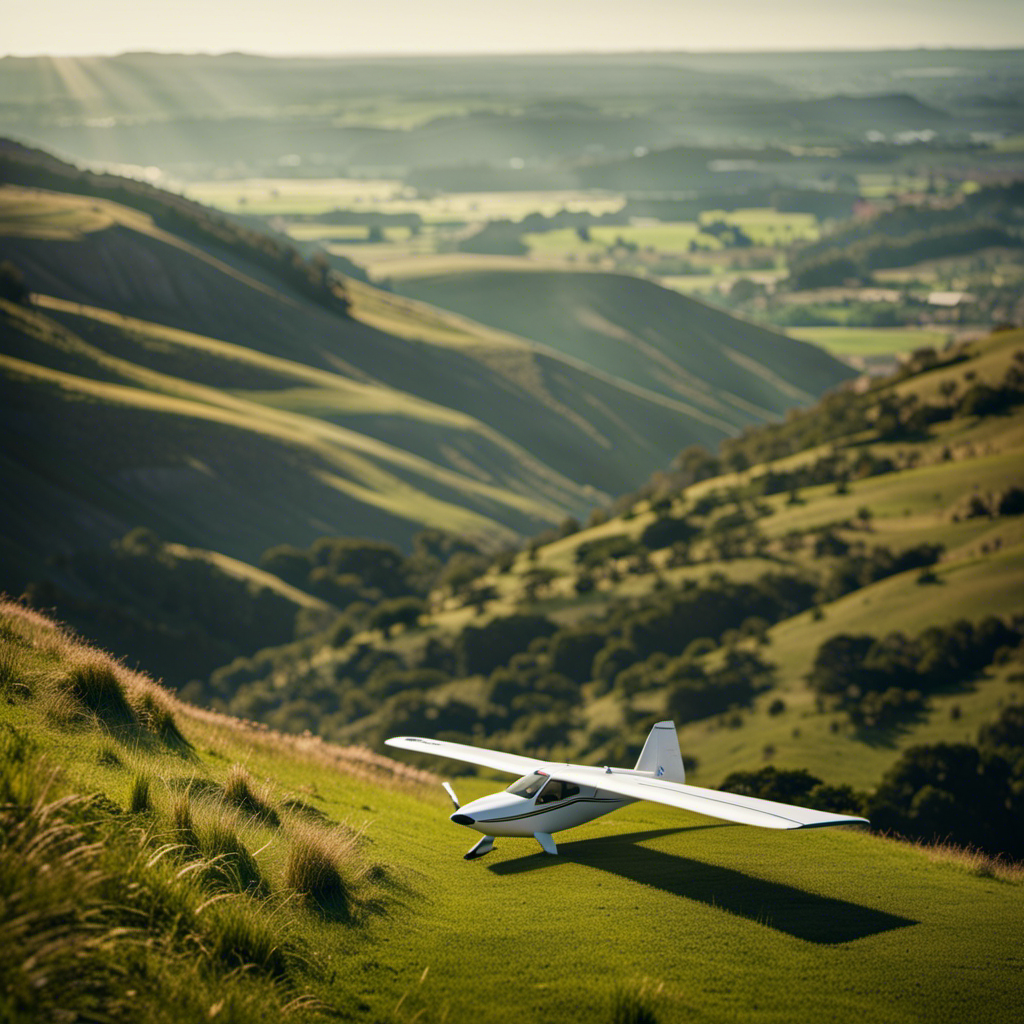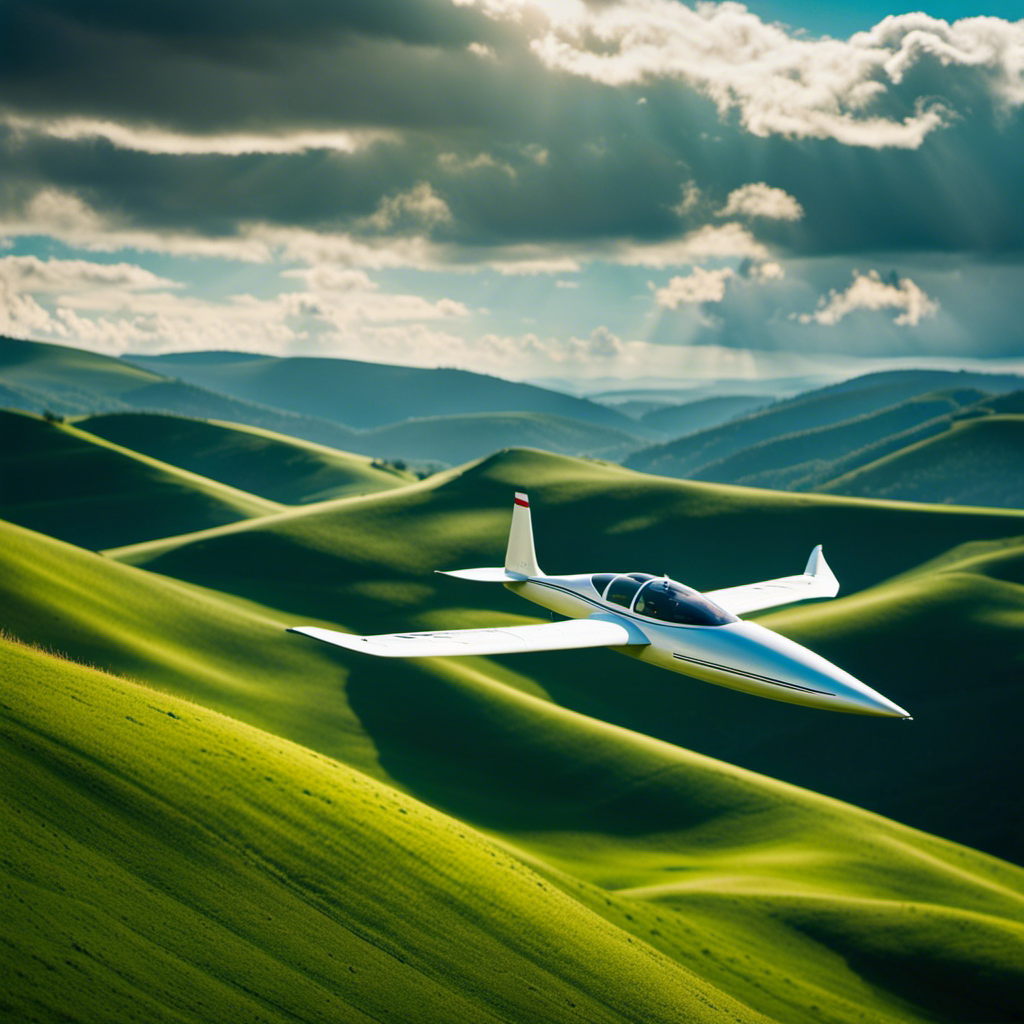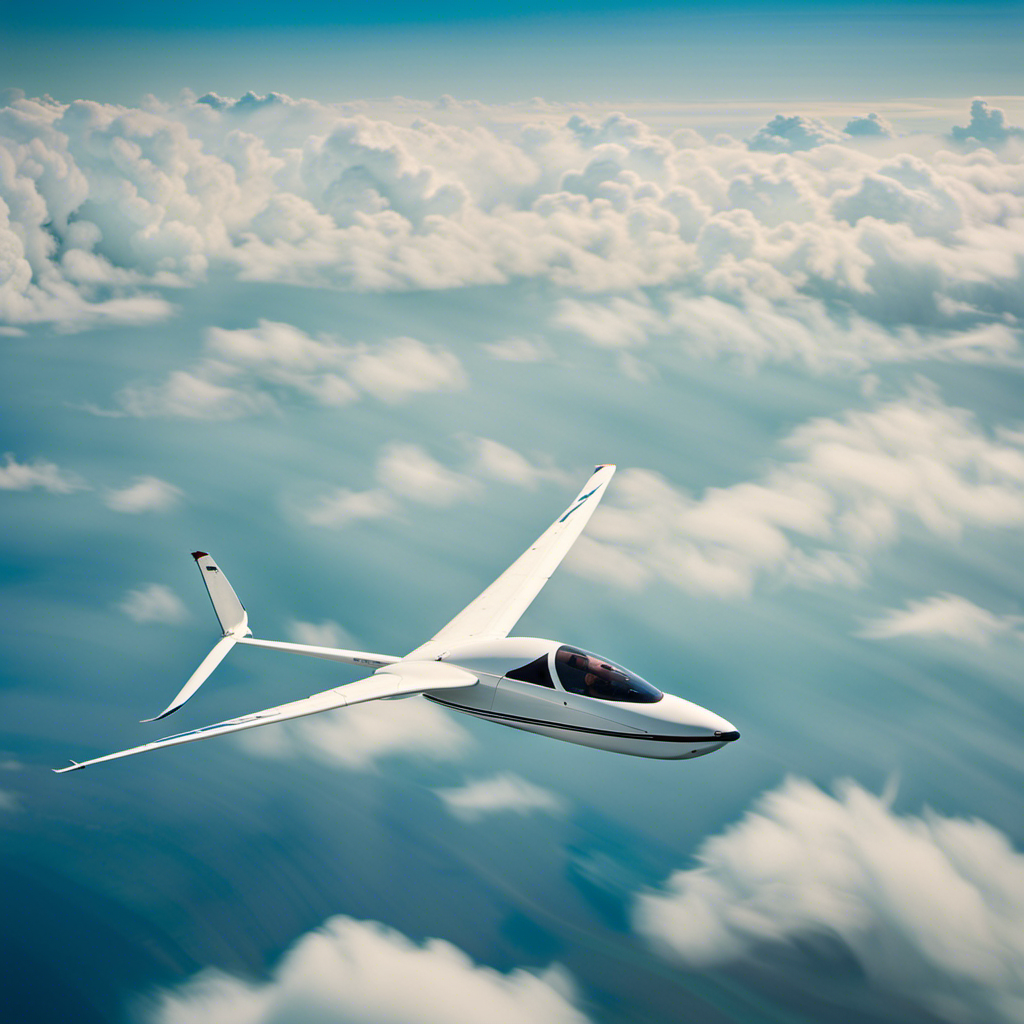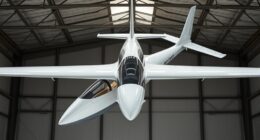As a glider pilot, I often get asked, “Can a glider launch itself?” This question is interesting because it highlights the unique way gliders work. Unlike traditional planes with engines, gliders cannot take off on their own. They rely on methods like aerotowing or winch launching to reach the necessary altitude.
In this article, we will explore the basics of glider flight, the role of wind and ground effect, and the importance of weight and balance in glider takeoffs. So buckle up and join me on this exhilarating journey into the world of glider takeoffs.
Key Takeaways
- Gliders can take off by themselves using self-launching methods.
- Glider takeoffs require an understanding of ground effect and wind gradient.
- Advanced techniques and future developments in glider takeoff technology offer exciting possibilities.
- Glider takeoffs provide a unique and exhilarating experience, emphasizing the importance of training and certification.
The Basics of Glider Flight
To understand the basics of glider flight, you need to know how a glider can stay airborne without an engine. Gliders rely on thermals, which are columns of rising air, to gain altitude and sustain flight. Understanding thermals is crucial for glider pilots as it allows them to maximize their time in the air.
Thermals are created when the sun heats the ground, causing the air above it to rise. Glider pilots can identify thermals by observing cumulus clouds or by using instruments that detect changes in air temperature and pressure. Glider performance, including the ability to climb efficiently within thermals, is influenced by factors such as wing design, weight, and pilot skill.
With this understanding of glider flight, we can now explore the various launch methods for gliders.
Launch Methods for Gliders
When it comes to launching gliders, there are several methods that can be utilized.
The first method is an aerotow launch, where the glider is connected to a powered aircraft via a towline and is pulled into the air.
Another method is a winch launch, where a powerful winch is used to rapidly reel in a cable attached to the glider, providing the necessary speed for takeoff.
Lastly, there are self-launching gliders, which have their own onboard engines that allow them to take off independently.
Each method has its own advantages and considerations, and understanding these launch methods is crucial for a successful glider flight.
Aerotow Launch
You can experience an aerotow launch where a powered aircraft tows the glider into the air. This method is widely used in gliding to achieve higher altitudes and longer flights. Aerotow launches require careful attention to aerotow safety and precise aerotow techniques.
During an aerotow launch, the glider is connected to the tow plane by a tow rope. As the tow plane accelerates down the runway, it lifts the glider off the ground. Once airborne, the glider pilot releases the tow rope, and the glider is free to soar through the sky.
To give you a better understanding of the aerotow launch process, here is a table describing the steps involved:
| Step | Description |
|---|---|
| 1 | Pre-flight checks and aircraft preparation |
| 2 | Tow plane accelerates down the runway |
| 3 | Glider lifts off the ground |
| 4 | Glider pilot releases the tow rope |
| 5 | Glider continues flight independently |
Now, let’s transition into the subsequent section about the ‘winch launch’ method, another way for gliders to take off.
Winch Launch
Another option for launching a glider is the winch launch. In this method, a powerful winch is used to rapidly pull the glider into the air. A long tow rope is attached to the glider and wound around a drum on the winch. As the winch is activated, the drum rapidly rotates, pulling the tow rope and accelerating the glider forward. The force generated by the winch allows the glider to quickly gain speed and lift off the ground.
The winch launch is a popular choice for glider pilots due to its efficiency and cost-effectiveness. However, compared to aerotow launches, winch launches typically offer shorter flight durations.
Now, let’s move on to the next section where we will explore self-launching gliders.
Self-Launching Gliders
A popular option for launching gliders is the self-launch method. This method allows the glider to take off on its own using a built-in engine. Self-launching gliders have become increasingly popular due to their ability to take off without the need for external assistance.
There are different self-launch techniques that can be used. One technique involves using a retractable engine, while another involves mounting a small motor on the glider’s fuselage. These techniques provide glider pilots with more independence and flexibility in their flights, as they can launch their aircraft without relying on a winch or a tow plane.
One of the benefits of self-launching gliders is that they can often reach higher altitudes. This allows pilots to take advantage of better thermals and extend their flight time. However, it is important for pilots to understand the concept of ground effect, as it plays a crucial role in the performance and efficiency of the aircraft during takeoff and landing.
Understanding Ground Effect
When you’re close to the ground, the wings of a glider create extra lift due to the ground effect. This phenomenon occurs because the airflow underneath the wings is compressed, resulting in increased pressure and therefore lift generation.
The ground effect is most pronounced when the glider is within a wingspan’s distance from the ground. This additional lift allows the glider to maintain a lower angle of attack and reduce drag, making it easier to take off and maintain controlled flight.
However, it is important to note that the ground effect diminishes as the glider gains altitude, so it plays a significant role mainly during the initial stages of takeoff.
Now, let’s explore the role of wind in glider takeoffs.
The Role of Wind in Glider Takeoffs
When it comes to glider takeoffs, understanding the role of wind is crucial. One key factor to consider is the wind gradient, which refers to the change in wind speed and direction with altitude. This gradient can affect the performance of a glider during takeoff and must be carefully considered.
Additionally, crosswind takeoffs pose their own challenges, as pilots need to be skilled in controlling the aircraft in sideways wind conditions to ensure a safe and successful departure.
Wind Gradient and its Effects on Takeoff
The wind gradient affects a glider’s takeoff. Wind shear, the sudden change in wind speed or direction, can have a significant impact on glider performance during takeoff. Turbulence caused by wind shear can make the glider unstable and difficult to control, affecting its ability to gain altitude and maintain a steady climb.
The effect of wind gradient on glider takeoff is particularly crucial because it determines the amount of lift the glider can generate. A steep wind gradient, with a rapid increase in wind speed with altitude, can provide a strong upward force and help the glider get off the ground quickly. On the other hand, a shallow wind gradient may result in a slower takeoff and require a longer runway.
Understanding the wind gradient is essential for a successful glider takeoff, especially when considering crosswind takeoffs.
Crosswind Takeoffs
To successfully perform a crosswind takeoff, you’ll need to adjust your technique and maintain control of the aircraft. Crosswind techniques are crucial in ensuring a safe and efficient departure. Here are two key factors to consider when performing a crosswind takeoff:
-
Proper rudder input: Applying the correct amount of rudder in the direction of the crosswind is essential to counteract the wind’s effect on the aircraft. This helps maintain alignment with the runway and prevents drifting off course.
-
Wing control: By keeping aileron deflection into the wind, you can counteract the rolling tendency caused by the crosswind. This helps maintain stability during the takeoff roll and minimizes the risk of a wingtip striking the ground.
Mastering these techniques is crucial to maximize glider performance and ensure a safe takeoff. As we transition into discussing the importance of weight and balance, it is important to note that proper crosswind techniques lay the foundation for a successful departure.
The Importance of Weight and Balance
Maintaining proper weight and balance is crucial for a glider to take off successfully. Weight distribution plays a significant role in determining the glider’s stability during takeoff. The weight must be evenly distributed to ensure a balanced flight. If the weight is not properly distributed, the glider may experience handling issues, making it difficult to control and potentially leading to a dangerous situation.
To adjust the balance, ballast can be added or removed from specific areas of the glider. This allows for fine-tuning the weight distribution to achieve optimal performance.
Now that we understand the importance of weight and balance, let’s delve into the runway requirements for glider takeoffs, which are essential for a safe and efficient launch.
Runway Requirements for Glider Takeoffs
In order to ensure safe and successful glider takeoffs, it is important to understand the minimum runway length required for these aircraft. The length of the runway directly impacts the ability of a glider to achieve the necessary lift and speed for takeoff.
Several factors can affect runway requirements for gliders. These factors include the weight and balance of the aircraft, wind conditions, and the presence of obstacles or obstructions on the runway. Considering these factors is crucial in determining the appropriate runway length for a glider takeoff.
Minimum Runway Length for Glider Takeoffs
You don’t need a long runway for glider takeoffs. As a glider pilot, I know that there are several factors affecting runway length and effective ground crew communication is crucial.
Here are some key points to consider:
-
Glider Performance: The performance of the glider itself, including its weight, wingspan, and aerodynamics, plays a significant role in determining the required runway length.
-
Wind Conditions: The direction and strength of the wind can affect the groundspeed of the glider during takeoff, allowing for shorter runway distances.
-
Runway Surface: The condition and texture of the runway surface can impact the glider’s rolling resistance and affect the required runway length.
-
Obstacles and Terrain: The presence of obstacles, such as trees or buildings, near the runway or on the flight path, can influence the necessary runway length for a safe takeoff.
Considering these factors, it is essential for glider pilots and ground crew members to communicate effectively to ensure a successful takeoff.
Now, let’s explore the factors that further dictate the runway requirements for glider operations.
Factors Affecting Runway Requirements
Transition: Now that we understand the minimum runway length required for glider takeoffs, let’s delve into the factors that affect these runway requirements.
Current Subtopic: Factors Affecting Runway Requirements
As a glider pilot, it is crucial to consider various factors that can influence the runway requirements for takeoff. The two primary factors are the runway surface and wind direction.
The type of runway surface plays a significant role in determining the length needed for a successful takeoff. A smooth and well-maintained runway allows for better traction and acceleration, reducing the required length. Conversely, a rough or uneven surface may increase the runway requirement due to decreased traction and potential damage to the glider or its landing gear.
Additionally, wind direction is crucial for glider takeoffs. A headwind provides added lift, allowing for shorter takeoff distances. Conversely, a tailwind can reduce lift and increase the required runway length.
Transition: Understanding these factors sets the stage for comprehending the vital role of the glider pilot in ensuring a safe and successful takeoff.
The Role of the Glider Pilot
As a glider pilot, I understand the importance of technique and skill in takeoff. The success of a takeoff relies heavily on the pilot’s ability to properly control the glider and maintain a precise trajectory.
Effective communication with the ground crew is also crucial, as it ensures a smooth and coordinated takeoff process, minimizing the risk of accidents or mishaps.
Pilot Technique and Skill in Takeoff
To improve your takeoff technique in a glider, it’s important to master the coordination between the controls and smoothly apply the necessary inputs. As a pilot, your technique plays a crucial role in the success of the launch.
Firstly, understanding the different launch methods is essential. Whether it’s a winch launch, aerotow, or self-launch, each method requires specific skills and adjustments. For example, during a winch launch, maintaining a straight and steady path while managing the tension on the line is crucial.
Similarly, during an aerotow, coordinating with the tow plane and smoothly transitioning from being under tow to flying independently is essential. By honing your pilot technique and adapting it to different launch methods, you can ensure a safe and efficient takeoff.
This sets the stage for a successful flight, which relies not only on the pilot’s skills but also on effective communication with the ground crew.
Communication with Ground Crew
When communicating with the ground crew, make sure to clearly convey your intentions and any necessary updates. Ground crew communication is an essential aspect of glider operations, ensuring the safety of both the pilot and those on the ground. As a pilot, it is crucial to provide the ground crew with accurate and concise information regarding your intentions, such as the desired takeoff direction and any changes in plans. This clear communication allows the ground crew to take the necessary safety considerations into account, such as adjusting the positioning of vehicles and personnel. To illustrate this, consider the following table:
| Information to Communicate | Examples |
|---|---|
| Takeoff direction | Runway 27 |
| Changes in plans | Delayed takeoff by 10 minutes |
The Limitations of Self-Sustained Glider Takeoffs
Although a glider can achieve lift without an engine, it relies on external factors for takeoff. The limitations and challenges of self-sustained glider takeoffs are as follows:
-
Runway length: Gliders require a longer runway compared to powered aircraft due to their lack of engine power. The longer runway allows for a higher takeoff speed, which is necessary for generating sufficient lift.
-
Weather conditions: Gliders heavily depend on favorable weather conditions for takeoff. Strong crosswinds, gusty winds, or adverse weather can make it unsafe or impossible to launch a glider.
-
Pilot skill and experience: Self-sustained glider takeoffs require a high level of skill and experience. Pilots must accurately assess wind conditions, manage the energy required for takeoff, and make precise control inputs to ensure a successful launch.
Considering these limitations and challenges, it is crucial to prioritize safety during glider takeoffs.
Safety Considerations for Glider Takeoffs
As we have discussed the limitations of self-sustained glider takeoffs, it is important to shift our focus to the safety considerations for glider takeoffs.
Understanding the proper procedures for glider takeoff is crucial to ensure a safe and successful flight. Before embarking on a glider takeoff, it is essential to conduct a thorough pre-flight inspection, checking for any signs of damage or malfunction. Additionally, pilots must ensure that the glider is properly balanced and loaded within its weight limits.
Adhering to these safety precautions mitigates the risk of accidents or malfunctions during takeoff, thereby ensuring the safety of both the pilot and the glider. By following these guidelines, pilots can confidently embark on their glider takeoff, knowing that they have taken the necessary steps to prioritize safety.
Moving forward, let’s explore some advanced techniques for glider takeoffs.
Advanced Techniques for Glider Takeoffs
When it comes to enhancing glider takeoff performance, there are advanced techniques that can be employed.
One such technique is dynamic soaring, which utilizes the energy from wind gradients to gain speed and height.
Additionally, wave lift and mountain launches can also be utilized to achieve a more efficient and powerful takeoff.
Dynamic Soaring for Enhanced Takeoff Performance
The glider can gain extra lift and improve its takeoff performance using dynamic soaring techniques. This method involves utilizing the wind gradients and air currents to generate energy and maintain altitude. Here are three key aspects of dynamic soaring that contribute to enhanced takeoff performance:
-
Wind gradient utilization: By flying close to the ground, the glider can take advantage of the difference in wind speed between the surface and higher altitudes. This gradient creates a pressure difference that generates additional lift, allowing the glider to gain altitude more efficiently during takeoff.
-
Energy conservation: Dynamic soaring techniques involve continuously transitioning between regions of different wind speeds and directions. By skillfully maneuvering in these zones, the glider can conserve energy and maintain or even increase its altitude, enabling longer and more efficient takeoffs.
-
Alternative launch methods: Dynamic soaring offers an alternative to traditional takeoff methods, such as tow launches or winch launches. Instead of relying on external forces, the glider can use the natural wind dynamics to propel itself into the air, reducing dependence on additional equipment and resources.
Wave Lift and Mountain Launches
Utilizing wave lift and mountain launches allows for increased altitude and improved takeoff performance.
Wave lift techniques involve harnessing the energy of atmospheric waves, which are created when wind encounters obstacles such as mountains or ridges. By flying in these wave patterns, gliders can gain altitude without the need for an external power source.
Additionally, mountain launches make use of the upward drafts created by the slopes of mountains. By positioning the glider correctly and taking advantage of the rising air, pilots can achieve a higher takeoff altitude and extend their flight time.
These techniques require skill and knowledge, as pilots must carefully read the weather conditions and select the optimal route for maximum lift. Mastering wave lift and mountain launches opens up new possibilities for glider pilots, allowing them to soar higher and longer than ever before.
Looking ahead, advancements in glider takeoff technology will continue to push the boundaries of what is possible.
The Future of Glider Takeoff Technology
In my analysis on the future of glider takeoff technology, I will be discussing two key points: electrically powered gliders and the development of hybrid propulsion systems.
Electrically powered gliders have gained significant attention in recent years due to their environmental benefits and potential for extended flight times.
The development of hybrid propulsion systems, combining electric motors with traditional engines, shows promise in providing the necessary power for takeoff while still maintaining efficiency during gliding.
Electrically Powered Gliders
Electrically powered gliders can be a great option for solo takeoffs. With an electric motor and battery power, these gliders can generate enough thrust to get airborne without the need for a tow or a winch launch. The electric motor provides instant power, eliminating the reliance on external sources.
The battery power ensures a clean and quiet operation, reducing the environmental impact. Electrically powered gliders offer the advantage of being able to take off from almost anywhere, making them ideal for pilots who want to explore new areas or fly from remote locations.
However, the development of hybrid propulsion systems has taken this concept even further, combining the benefits of electric and traditional propulsion to provide extended range and increased versatility. With these advancements, the possibilities for glider takeoff technology continue to expand.
Development of Hybrid Propulsion Systems
With hybrid propulsion systems, you can now enjoy extended range and increased versatility when flying your electrically powered glider. These systems combine the benefits of an electric motor with a traditional internal combustion engine, addressing the challenges of limited battery capacity and the need for sustained power. By seamlessly switching between the two power sources, hybrid propulsion systems provide a reliable and efficient solution for gliders.
To better understand the advantages of hybrid technology, let’s take a look at the following table:
| Hybrid Propulsion Systems |
|---|
| Extended Range |
| Increased Versatility |
| Efficient Power |
As technology continues to advance, future advancements in hybrid propulsion systems are expected. Researchers are exploring ways to optimize battery capacity and improve the efficiency of internal combustion engines. These advancements will further enhance the capabilities of hybrid gliders, allowing for even longer flights and improved performance.
Transitioning to the subsequent section, let’s now explore some famous glider takeoff records and achievements.
Famous Glider Takeoff Records and Achievements
You won’t believe the incredible glider takeoff records and achievements accomplished by famous pilots.
Throughout history, pilots have pushed the boundaries of glider technology, leading to remarkable achievements in self-launching gliders and advanced techniques for glider takeoffs.
One notable record was set by Steve Fossett in 2006, who achieved the first solo non-stop flight around the world in a glider. This groundbreaking feat demonstrated the capabilities of self-launching gliders, which can take off without the need for a tow plane or winch.
Other famous pilots, such as Klaus Ohlmann and Sebastian Kawa, have achieved numerous records for altitude, distance, and duration in glider takeoffs. These achievements highlight the skill, expertise, and innovation required to master the art of glider takeoffs.
Transitioning into the subsequent section, the joy of glider takeoffs is a testament to the thrill and freedom that flying in a glider provides.
The Joy of Glider Takeoffs
Transitioning into the subsequent section, experiencing the thrill and freedom of glider takeoffs is an incredible feeling. Here are four reasons why glider takeoffs are so exhilarating:
-
Ground effect: As the glider accelerates down the runway, it enters the ground effect zone, where the cushion of air between the wings and the ground provides an extra lift. This sensation of effortlessly gliding above the surface is truly mesmerizing.
-
Wind gradient: During the takeoff, the glider encounters varying wind speeds and directions at different altitudes. Skillfully navigating through these changes requires precise control and a deep understanding of the aerodynamics involved.
-
Sense of weightlessness: As the glider lifts off the ground, there is a brief moment of weightlessness, where you feel like you’re floating in the air. It’s a sensation that can only be experienced in the world of glider aviation.
-
Connection with nature: Glider takeoffs allow you to connect with nature in a unique way. The absence of an engine noise and reliance on natural forces create a serene environment where you can appreciate the beauty of the sky and the earth below.
With the anticipation building during the takeoff, it’s no wonder that glider pilots find this aspect of their training and certification process so captivating.
Glider Takeoff Training and Certification
During glider takeoff training and certification, pilots must demonstrate precise control and a deep understanding of aerodynamics. Mastering glider takeoff techniques is crucial for a safe and successful flight.
Safety measures are paramount in this phase of training, as takeoff is a critical moment where the pilot has to ensure a smooth and controlled ascent. Pilots must utilize a combination of techniques, such as proper weight distribution, correct elevator control, and timely application of airbrakes, to achieve the desired lift-off.
Additionally, pilots need to be aware of wind conditions, runway length, and other environmental factors that may affect the takeoff process. By following established procedures and adhering to safety guidelines, pilots can confidently navigate the challenges of glider takeoff, setting the stage for an exhilarating and rewarding flight experience.
Conclusion: The Fascinating World of Glider Takeoffs
To wrap up this captivating exploration of glider takeoffs, it’s astonishing to witness the precise control and deep understanding of aerodynamics that pilots demonstrate during this phase of training and certification. The techniques used for glider takeoffs require a thorough comprehension of the principles of aerodynamics and the ability to apply them in real-time.
Throughout their training, pilots learn various takeoff techniques that maximize the efficiency and safety of the glider’s ascent. These techniques include:
| Takeoff Technique | Description |
|---|---|
| Winch Launch | The glider is connected to a winch by a cable, which rapidly pulls it into the air. |
| Aerotow | A powered aircraft tows the glider into the air with a rope, gradually increasing altitude. |
| Self-Launch | Gliders equipped with a motor can initiate the takeoff independently. |
Pilots must carefully choose the appropriate technique based on factors such as weather conditions, runway length, and aircraft capabilities. Their expertise enables them to execute a smooth and controlled takeoff, setting the stage for a successful flight.
Frequently Asked Questions
Are there any specific safety considerations to keep in mind during glider takeoffs?
When it comes to glider takeoffs, there are several safety considerations and necessary precautions to keep in mind. These include wind speed and direction, runway conditions, weight and balance, and proper pre-flight inspections.
What are the limitations of self-sustained glider takeoffs?
The limitations of self-sustained glider takeoffs include the need for an adequate runway length, suitable wind conditions, and sufficient power from the glider’s engine. Without these factors, self-sustained takeoffs may not be possible.
Are there any advanced techniques that can be used for glider takeoffs?
Yes, there are advanced techniques that can be used for self-sustained glider takeoffs. These techniques involve utilizing specific launch methods, such as aerotow or winch launch, to generate the initial lift needed for takeoff.
How does ground effect affect glider takeoffs?
Ground effect is the increased lift and decreased drag experienced by a glider when it is close to the ground. This phenomenon allows for shorter takeoff runs and can significantly enhance glider aerodynamics during takeoff.
What is the future of glider takeoff technology?
The future of glider takeoff technology is filled with exciting advancements. Autonomous systems are being developed to allow gliders to take off on their own, revolutionizing the way we launch these aircraft.
Conclusion
In conclusion, glider takeoffs are a fascinating aspect of aviation that require skill, knowledge, and precision. By harnessing the power of wind, utilizing launch methods, and understanding ground effect, gliders are able to achieve flight without the need for an engine.
Weight and balance play a crucial role in ensuring a successful takeoff, while glider takeoff records and achievements showcase the incredible feats that can be accomplished.
As the adage goes, ‘The sky’s the limit,’ and the world of glider takeoffs certainly proves that to be true.









